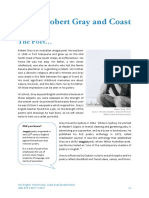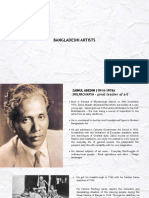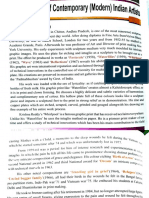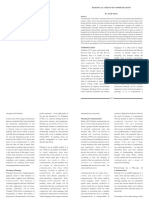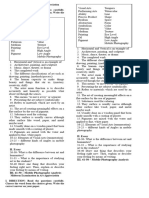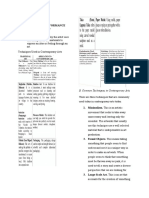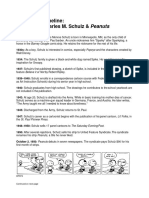Final Artist Description
Final Artist Description
Uploaded by
PrakritiCopyright:
Available Formats
Final Artist Description
Final Artist Description
Uploaded by
PrakritiOriginal Title
Copyright
Available Formats
Share this document
Did you find this document useful?
Is this content inappropriate?
Copyright:
Available Formats
Final Artist Description
Final Artist Description
Uploaded by
PrakritiCopyright:
Available Formats
Benode Behari Mukherjee (1904-1980)
Born in 1904 in Behala, Bengal, Benode Behari Mukherjee joined Santiniketan in 1917 and Kala Bhavana in 1919,
where he was one of the first students of Nandalal Bose. A congenitally impaired vision that denied him normal
schooling and resulted in a lonely childhood, brought him close to nature and had a deep impact on his art.
Though Mukherjee turned completely blind by the time he turned 50, his creative urge remained undiminished.
He began making drawings and small sculptures based upon figural images achieved by folding paper. He also
took to serious writing, using it as a tool to express his personal views on art. In 1973, Satyajit Ray made a
documentary on his work, called The Inner Eye. Mukherjee received two literary awards, the Rabindra Puraskar
and the Bhartiya Bhasha Parishad Award, the latter in the year of his death.
Description
Style of Art
A Title: Lady with Fruit
R Creator: Benode
Behari Mukherjee
Lady with Fruit 1957 is a paper collage on
Mukherjee renounced the overt card that depicts a female figure, seen
symbolism of mythology in favour T Date Created: 1957
Physical Dimension:
frontally and positioned in the centre of the
of themes from everyday life. The almost square composition. She holds a
expressionism of his early works W Support: 257 × 280
mm
number of brightly coloured items in her
may be compared with the work hands and lap, and is surrounded by
of the German expressionist O Type: Paper and
graphite on paper
abstract shapes in similarly bold colours,
group Die Brucke. A visit to Japan including orange, green, pink, blue and
in 1936 proved particularly R Other Works:
Mountains,
yellow. All of the forms in the composition
significant as he was an admirer of are made from pieces of cut paper in bright
the Tosa School of Painting. K Laughter, Game etc.
hues that are pasted onto beige-coloured
Experimenting constantly in his card.
drawings, sketches, woodcuts, dry- Conclusion/ Note on my understanding
points and lithographs, he soon "Against all odds"is perhaps the most apt phrase to describe the inspiring journey of Benode
diversified to mural paintings. His Behari Mukherjee - one of India's most celebrated modern artists. His contribution to the References:-
perceptions of the Santiniketan development of Indian art is immensely significant; though it is his life's message of continuously https://www.tate.org.uk/art/artworks/
landscape and campus life found learning and doing that is his ultimate legacy. He always took inspiration from Nature and his mukherjee-lady-with-fruit-t14329
artistic expression in several surroundings. His art did not reflect any any nationalistic tendencies, they instead revealed his https://www.theheritagelab.in/benode
compositional calligraphic affinity towards landscapes. He became the first indian artist to travel to Japan & exhibit his work beharimukherjee-indian-artist/
paintings. Mukherjee travelled there. He was a man of many talents. If we look at his artworks, we'd find sketches, water colors, https://engrave.in/blog/indian-art-
widely, becoming for a brief while binod-behari-mukherjee/
tempera on wood, works on silk, felt tip pen and chinese ink on paper, textile block print, etchings,
the curator at the Nepal https://en.wikipedia.org/wiki/Benode_
lithographs and his paper collages. What is even more stunning about the mural is the fact that Behari_Mukherjee
Government Museum in Benode Behari executed it spontaneously-without any priorly made sketches /plans!
Kathmandu, a period when he By 1957 he had lost his eyesight completely - but not his vision. Mukherjee's disability did not
Created by:
painted the country in a series of PRAKRITI GORAI
hinder his creativity either. Mukherjee turned to paper collage as a medium for artistic expression
drawings and watercolours. (BFT/19/75)
in 1957 when he lost his sight, at the age of fifty-three. His work reflected his dedication even
though he had many challenges.
You might also like
- Comparative Study GM FinalDocument20 pagesComparative Study GM Finalapi-541183942100% (1)
- Casual Shirt Production ProcessDocument38 pagesCasual Shirt Production ProcessPrakriti80% (5)
- Robert Gray ContextDocument5 pagesRobert Gray ContextJack StrangerNo ratings yet
- S H RazaDocument6 pagesS H RazaAlphy maria cherian100% (1)
- Finishes On KidswearDocument10 pagesFinishes On KidswearPrakritiNo ratings yet
- Washing and Drying in Garment Industry: Spme Ii Assignment 2Document11 pagesWashing and Drying in Garment Industry: Spme Ii Assignment 2Prakriti100% (1)
- Year 9 Basic Technology Text Book PDFDocument115 pagesYear 9 Basic Technology Text Book PDFPranish Vinay Chand100% (6)
- Post Bengal SchoolDocument13 pagesPost Bengal SchoolSanskar MohapatraNo ratings yet
- Saint Benilde: Course OutlineDocument6 pagesSaint Benilde: Course Outlinejustine alinaNo ratings yet
- Razatantra e CatalogueDocument17 pagesRazatantra e CatalogueAnupamNo ratings yet
- Visual Arts Comparative StudyDocument20 pagesVisual Arts Comparative Studyapi-317918711No ratings yet
- LG #1-4 CparDocument10 pagesLG #1-4 Cparreev.guinaNo ratings yet
- IrezumiBlackwork - Hugo Soderholm MogensenDocument11 pagesIrezumiBlackwork - Hugo Soderholm Mogensenx6x6 x6No ratings yet
- Drawing PortraitsDocument55 pagesDrawing PortraitsAnime_Pornstar100% (15)
- Spring Catalogue HKFINEART GALLERYDocument28 pagesSpring Catalogue HKFINEART GALLERYabhishekforeanandNo ratings yet
- INDIAN GRAPHIC PRINTS - Docx-1Document4 pagesINDIAN GRAPHIC PRINTS - Docx-1sharma.saumya0737No ratings yet
- Madhubani The Soul of ArtDocument6 pagesMadhubani The Soul of ArtArunim SrivastavaNo ratings yet
- MadhubaniDocument25 pagesMadhubanisinhabaibhawiNo ratings yet
- Arts 8 Quarter 3 SLM 1Document5 pagesArts 8 Quarter 3 SLM 1Caryll BaylonNo ratings yet
- Modern Indian ArtDocument19 pagesModern Indian Artfrancy sharonNo ratings yet
- Anish Kapoor: Interview by KIM HEIRSTONDocument11 pagesAnish Kapoor: Interview by KIM HEIRSTONselin eryılmazNo ratings yet
- Art PresentationDocument9 pagesArt PresentationKaryn DanuartaNo ratings yet
- Bangladeshi ArtistsDocument104 pagesBangladeshi ArtistsGeorge Luke100% (1)
- Reference Comparative Study - ADocument19 pagesReference Comparative Study - Ajanvi karnawatNo ratings yet
- Adobe Scan Feb 17, 2021Document12 pagesAdobe Scan Feb 17, 2021Anikesh singhNo ratings yet
- Worksheet 1: Contemporary Arts First SemesterDocument11 pagesWorksheet 1: Contemporary Arts First SemesterKrystal JungNo ratings yet
- Cheriyal Painting - TelanganaDocument37 pagesCheriyal Painting - Telanganaraish alamNo ratings yet
- Summary of A WriterDocument3 pagesSummary of A Writerrg. constanzaNo ratings yet
- More Than Words by Fazreen Sukri 3 17 Sep 2022 at G13 Project Room CatalogueDocument12 pagesMore Than Words by Fazreen Sukri 3 17 Sep 2022 at G13 Project Room CatalogueZulhaziq Irfan Mohd ZulkifliNo ratings yet
- Transformations in The Art of Sayed Haider Raza: Research Scholar, Panjab University, ChandigarhDocument3 pagesTransformations in The Art of Sayed Haider Raza: Research Scholar, Panjab University, Chandigarhঅভীক সরকারNo ratings yet
- Civardi, - Giovanni - Drawing - Portraits, - Faces - and - Figures (1) - Part-1Document15 pagesCivardi, - Giovanni - Drawing - Portraits, - Faces - and - Figures (1) - Part-1Leonardo HenriqueNo ratings yet
- Painting As Means of CommunicationDocument9 pagesPainting As Means of CommunicationYana ArsyadiNo ratings yet
- Gallery Nine SnapshotDocument3 pagesGallery Nine Snapshotrupalpatel0000No ratings yet
- Pen and Ink Book PDFDocument16 pagesPen and Ink Book PDFRohit Kumar Singh100% (2)
- Artistic ResearchDocument3 pagesArtistic Researchwei chenNo ratings yet
- Divisions of Art StudyDocument21 pagesDivisions of Art StudyJewel SkyNo ratings yet
- Coming This Year!: Georges SeuratDocument4 pagesComing This Year!: Georges Seuratlollocala5215100% (1)
- White Decorative Portfolio Cover DocumentDocument5 pagesWhite Decorative Portfolio Cover DocumentTan Jian HongNo ratings yet
- Lesson 4 Visual Arts Painting Drawing PhotographyDocument4 pagesLesson 4 Visual Arts Painting Drawing Photographysydney.socoNo ratings yet
- Artist Study On Joan Gris: by Yash ShrivastavaDocument10 pagesArtist Study On Joan Gris: by Yash ShrivastavaYash ShrivastavaNo ratings yet
- Midterm Examination in Art AppreciationDocument1 pageMidterm Examination in Art AppreciationRomeo PilongoNo ratings yet
- Comparative Study: Thy LeDocument6 pagesComparative Study: Thy LeThy LeNo ratings yet
- Lesson 3 Discussion NotesDocument7 pagesLesson 3 Discussion NotesSEAN ANDREX MARTINEZNo ratings yet
- Art Critique: Solitude in The 21St CenturyDocument3 pagesArt Critique: Solitude in The 21St CenturyPrincess NozalNo ratings yet
- Beri - Spaces - Inspired - by - Nature - eDocument22 pagesBeri - Spaces - Inspired - by - Nature - eNeha Pramod Ghatage100% (2)
- Types of Visual Arts HandoutsDocument8 pagesTypes of Visual Arts Handoutstgakabankalan tgakabankalan100% (1)
- Folk Art: Group Members: Avani Diya Vetan Dilshan Oum Priyanka Samarth MDocument25 pagesFolk Art: Group Members: Avani Diya Vetan Dilshan Oum Priyanka Samarth Mqwerty222No ratings yet
- Medium of ArtDocument13 pagesMedium of ArtEdlyn ResuelloNo ratings yet
- Drawing and WatercolourDocument120 pagesDrawing and WatercolourVartikka Kaul100% (4)
- c40uyZGjQNuNLsmRo1Db6Q - Lynette Yiadom Boakye Paulina PobochaDocument1 pagec40uyZGjQNuNLsmRo1Db6Q - Lynette Yiadom Boakye Paulina Pobochaankita kasarNo ratings yet
- Degracia, John Noeh D. Hum Finals BSN 1-EDocument4 pagesDegracia, John Noeh D. Hum Finals BSN 1-ELenie DegraciaNo ratings yet
- Art AppreciationDocument2 pagesArt Appreciationpaguio.iieecscNo ratings yet
- Lesson 1 ContempDocument42 pagesLesson 1 ContempDereck MartinNo ratings yet
- Zbigniew Beksinski EnglishDocument9 pagesZbigniew Beksinski EnglishZuzanna DunneNo ratings yet
- Adobe Scan Feb 13, 2021Document8 pagesAdobe Scan Feb 13, 2021Anikesh singhNo ratings yet
- Erika A Amat - Journal Prompts in Gec07Document9 pagesErika A Amat - Journal Prompts in Gec07Erika AmatNo ratings yet
- REVESDocument24 pagesREVESSamantha Noreen ParallagNo ratings yet
- ART APPRECIATION HANDOUT FOR EDIT ReviewerDocument6 pagesART APPRECIATION HANDOUT FOR EDIT ReviewerHanifa NorodinNo ratings yet
- IHAAC MidtermDocument20 pagesIHAAC MidtermPRACHI KASHYAPNo ratings yet
- Sublime ContoursDocument5 pagesSublime ContoursKaustav PatraNo ratings yet
- Assessment II. Essay. Below The Statements About 20Document8 pagesAssessment II. Essay. Below The Statements About 20Diana Rose PaceloNo ratings yet
- UntitledDocument43 pagesUntitledJoel OblanNo ratings yet
- ARTAPP103 Module 6 Two Dimensional MediaDocument20 pagesARTAPP103 Module 6 Two Dimensional MediaBerna QuiambaoNo ratings yet
- TPM (Total Productive Manitainance) Vs TQM: Three WordsDocument23 pagesTPM (Total Productive Manitainance) Vs TQM: Three WordsPrakritiNo ratings yet
- Textile InternshipDocument8 pagesTextile InternshipPrakritiNo ratings yet
- Internship Report (Prakriti and Riya)Document39 pagesInternship Report (Prakriti and Riya)PrakritiNo ratings yet
- IoT Assn 1Document3 pagesIoT Assn 1Prakriti0% (1)
- Terotechnology: A Modern Approach To Plant EngineeringDocument6 pagesTerotechnology: A Modern Approach To Plant EngineeringPrakritiNo ratings yet
- Good Afternoon Everyone. What Is Kanban (1Document9 pagesGood Afternoon Everyone. What Is Kanban (1PrakritiNo ratings yet
- Lean ManagementDocument20 pagesLean ManagementPrakritiNo ratings yet
- Temple ArchitectureDocument12 pagesTemple ArchitecturePrakritiNo ratings yet
- Maintenance Management Assignment 1: Total Productive Maintenance in RMG IndustryDocument15 pagesMaintenance Management Assignment 1: Total Productive Maintenance in RMG IndustryPrakritiNo ratings yet
- Chhau Mask: Presented By: Prakriti Gorai (BFT/19/75)Document11 pagesChhau Mask: Presented By: Prakriti Gorai (BFT/19/75)PrakritiNo ratings yet
- Seam Puckering and Its Types: Submitted By: Prakriti Gorai (B F T / 1 9 / 7 5) Semester 4Document9 pagesSeam Puckering and Its Types: Submitted By: Prakriti Gorai (B F T / 1 9 / 7 5) Semester 4PrakritiNo ratings yet
- Product Specification Sheet: Understanding Apparel QualityDocument7 pagesProduct Specification Sheet: Understanding Apparel QualityPrakritiNo ratings yet
- Seam Puckering and Its TypesDocument9 pagesSeam Puckering and Its TypesPrakriti100% (1)
- Kolhapuri Chappal Craft Cluster StudyDocument54 pagesKolhapuri Chappal Craft Cluster StudyPrakriti100% (1)
- Timeline of Charles M Schulz and PeanutsDocument2 pagesTimeline of Charles M Schulz and Peanutssantiirusta2009No ratings yet
- How To Draw Kawaii Cute Animals CharacteDocument2 pagesHow To Draw Kawaii Cute Animals CharacteAyrton LuckerNo ratings yet
- Mock Test UceedDocument37 pagesMock Test UceedMerakiNo ratings yet
- Cartooning Caricatures Grade 7 Lesson 3 Class 1Document3 pagesCartooning Caricatures Grade 7 Lesson 3 Class 1api-544731570No ratings yet
- Engineering Drawing For BeginnersDocument27 pagesEngineering Drawing For Beginnersmohammad afzalNo ratings yet
- Design and Technology: An International JournalDocument115 pagesDesign and Technology: An International JournalTecnología Fácil (TecnoFacilMX)No ratings yet
- Area Chart:: Proposed Residence at G-37, East of Kailash, New DelhiDocument1 pageArea Chart:: Proposed Residence at G-37, East of Kailash, New DelhiVinayak AggarwalNo ratings yet
- Before You Read: Artistic TalentDocument1 pageBefore You Read: Artistic TalentRita Barnes0% (1)
- Hvac System-Design & Drafting As Per Ahsrae StandardsDocument2 pagesHvac System-Design & Drafting As Per Ahsrae StandardsAnkit Dua100% (1)
- Igcse Art and Design Coursework ExamplesDocument6 pagesIgcse Art and Design Coursework Examplesafiwftfbu100% (2)
- Issued For Construction: Panel MV UnigearDocument4 pagesIssued For Construction: Panel MV UnigearIrfan MaulanaNo ratings yet
- ILL Lesson1Document21 pagesILL Lesson1Emerson GongoraNo ratings yet
- Andrea Del SartoDocument5 pagesAndrea Del SartoNaseeb khanNo ratings yet
- Engineering Drawing and Computer Graphics: Rajaram Lakkaraju Mechanical Engineering, IIT KharagpurDocument45 pagesEngineering Drawing and Computer Graphics: Rajaram Lakkaraju Mechanical Engineering, IIT KharagpurNavinNo ratings yet
- Grade8 Q0 W5 PreparingInterpretingTechdraw For STUDENTDocument26 pagesGrade8 Q0 W5 PreparingInterpretingTechdraw For STUDENTRoldan Dela CruzNo ratings yet
- NSX S201Document4 pagesNSX S201api-3703813No ratings yet
- The Elements of Drawing, by John Ruskin 1Document95 pagesThe Elements of Drawing, by John Ruskin 1GeomanjeriNo ratings yet
- Hrolfsson GothicDocument21 pagesHrolfsson GothicFernando G. ToledoNo ratings yet
- Sketching The LandscapeDocument22 pagesSketching The LandscapeJerzy Mae GloriosoNo ratings yet
- Appartment LayoutDocument1 pageAppartment LayoutChaudhari SAnketNo ratings yet
- Arts 4,5,6Document5 pagesArts 4,5,6manescankaye2No ratings yet
- Picture Book Charles Ghigna IllusDocument2 pagesPicture Book Charles Ghigna Illusapi-508307805No ratings yet
- Lesson Plan: Date and Time Group Resources Learning ObjectivesDocument41 pagesLesson Plan: Date and Time Group Resources Learning ObjectivesTatiane AndradeNo ratings yet
- Section - BB: Hindware Showroom DisplayDocument1 pageSection - BB: Hindware Showroom DisplayPRAVEEN KUMARNo ratings yet
- Example PlanDocument1 pageExample Planmoondonoo7No ratings yet
- Visualization of Structures PDFDocument3 pagesVisualization of Structures PDFNitish TakalkarNo ratings yet
- 001 Fashion Design Illustration For Beginners - Class Resource List PDFDocument20 pages001 Fashion Design Illustration For Beginners - Class Resource List PDFTinsae Adane0% (1)
- Book Extension Activity - Lesson PlanDocument2 pagesBook Extension Activity - Lesson Planapi-612054311No ratings yet
- Introduction To Basic Electrical Drawings and Test Equipment - RevisedDocument7 pagesIntroduction To Basic Electrical Drawings and Test Equipment - RevisedShiela Mae Pacampara GonzalesNo ratings yet


